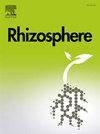Nutrient and stoichiometric characteristics of various organs in three typical desert plants from extreme desert ecosystems
IF 3.5
3区 生物学
Q1 PLANT SCIENCES
引用次数: 0
Abstract
Predicting how fragile and sensitive desert ecosystems will react to environmental changes depends on understanding how soil factors influence plant nutrient concentration and stoichiometry. We studied nutrients and stoichiometric characteristics of various organs of three desert plants (Alhagi sparsifolia, Tamarix ramosissima, and Calligonum caput-medusae) in Turpan (TLF), Tarim (CL), and Dzungaria (MSW) basins of Xinjiang, China. The results showed that in three regions (CL, MSW, and TLF), the nutrient levels of total nitrogen (TN) and total potassium (TK) in the leaves, roots, and branches of A. sparsifolia were significantly higher than those of C. caput-medusae. The total phosphorus (TP) contents in the leaves, roots, and branches of A. sparsifolia were significantly higher than those of T. ramosissima and C. caput-medusae. However, the nitrogen-to-phosphorus ratio in the leaf of C. caput-medusae was significantly lower compared with A. sparsifolia and T. ramosissima. A. sparsifolia had higher root organic carbon content compared with its branches and leaves, while its leaves had higher nutrient levels of TN and TK compared with its roots and branches. The leaf organic carbon contents of T. ramosissima and C. caput-medusae were lower compared with roots and branches, but higher leaf nutrients (TN, TP, and TK contents) than in roots and branches. The soil nutrients of three desert plants experienced significant nitrogen and phosphorus element limitations. Soil electrical conductivity (EC) was identified as a common environmental factor influencing the nutrient changes in the leaves, branches, and roots of desert plants. The structural equation model that soil pH was positively correlated with branch and root stoichiometry, however, soil EC was negatively correlated with root stoichiometry. This research offers a scientific foundation and essential information for the conservation and rehabilitation of desert ecosystems.
极端沙漠生态系统中3种典型荒漠植物各器官的营养和化学计量学特征
预测脆弱和敏感的沙漠生态系统将如何对环境变化作出反应取决于了解土壤因子如何影响植物养分浓度和化学计量学。研究了吐鲁仑盆地、塔里木盆地和准噶尔盆地3种荒漠植物(Alhagi sparsifolia,柽柳,caliigonum caputal -medusae)的养分和各器官的化学计量学特征。结果表明:在低海拔、高海拔、高海拔3个区域,疏叶松叶、根、枝的总氮(TN)和总钾(TK)含量均显著高于锦葵;疏叶松的叶、根、枝总磷含量均显著高于毛毛松和水母松。然而,与疏叶金针菇和毛毛金针菇相比,毛毛金针菇叶片的氮磷比显著降低。疏叶松根系有机碳含量高于枝条和叶片,叶片TN和TK的营养水平高于根系和枝条。毛毛柽柳和毛毛柽柳的叶片有机碳含量低于根和枝,但叶片营养物质(全氮、全磷和全钾)含量高于根和枝。3种荒漠植物土壤养分均存在显著的氮磷元素限制。土壤电导率(EC)是影响荒漠植物叶、枝、根养分变化的常见环境因子。结构方程模型表明,土壤pH与根、枝化学计量量呈正相关,土壤EC与根化学计量量呈负相关。该研究为沙漠生态系统的保护和恢复提供了科学依据和重要信息。
本文章由计算机程序翻译,如有差异,请以英文原文为准。
求助全文
约1分钟内获得全文
求助全文
来源期刊

Rhizosphere
Agricultural and Biological Sciences-Agronomy and Crop Science
CiteScore
5.70
自引率
8.10%
发文量
155
审稿时长
29 days
期刊介绍:
Rhizosphere aims to advance the frontier of our understanding of plant-soil interactions. Rhizosphere is a multidisciplinary journal that publishes research on the interactions between plant roots, soil organisms, nutrients, and water. Except carbon fixation by photosynthesis, plants obtain all other elements primarily from soil through roots.
We are beginning to understand how communications at the rhizosphere, with soil organisms and other plant species, affect root exudates and nutrient uptake. This rapidly evolving subject utilizes molecular biology and genomic tools, food web or community structure manipulations, high performance liquid chromatography, isotopic analysis, diverse spectroscopic analytics, tomography and other microscopy, complex statistical and modeling tools.
 求助内容:
求助内容: 应助结果提醒方式:
应助结果提醒方式:


